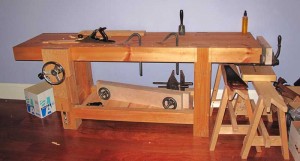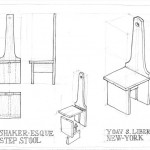We may receive a commission when you use our affiliate links. However, this does not impact our recommendations.
When I was planning my “petite Roubo” 18 months ago or so, the original idea that Christopher Schwarz and I cooked up was to use one slab of wood for an 18″ to 20″-wide top, because that would be historically accurate.
Slabs of wood that are 4″ thick were, however, easier to find a century or two ago than they are today, so the choices were limited.
After a bit of searching, we came across Bark House, a North Carolina-based company that specializes in (among other things) massive slabs of wood suitable for live-edge mantels, bar tops and the like. So we placed an order.
 I don’t recall how we decided on cedar – or if Bark House decided on it for us. All I know is that a few weeks later, a truck with a flatbed trailer pulled up to our loading dock with what looked like half a log strapped it.
I don’t recall how we decided on cedar – or if Bark House decided on it for us. All I know is that a few weeks later, a truck with a flatbed trailer pulled up to our loading dock with what looked like half a log strapped it.
We fully intended to use it for the benchtop. But then we pulled out the moisture meter. While I don’t recall the exact number that registered, I’m pretty sure it was in the low 20s. By the time that acclimates, I may be eligible for social security.
Plan B it was: a 4″-thick laminated pine top, with some letf-over log cabin logs scavenged from Craigslist.
Now, however, as we prepare to move Popular Woodworking Magazine one mile down the road to our new magazine office and shop (seriously – we’ll still in the same ZIP code), that honkin’ big slab of cedar remains on our wood rack.
I suggested we hold a design contest, and build the winning entry. I was told that was a horrible idea.
Almost everything I’ve built has been out of pine, cherry, walnut and maple. I’ve never worked with cedar beyond lining a blanket chest with S4S lumber. Cedar, I’m assured, is a b*tch with which to work.
I still think it would make an awesome bench…at about 18″ high, set across two tree stumps outside the new shop, so we have a place to sit and eat lunch. But that seems rather a waste of a lovely piece of wood.
So no contest. But I’d still like to hear your ideas for this slab. Feel free to drop by the new shop in a few weeks; we can sit on the new bench and chat about it.
• If you happen to have a massive slab of, say, Southern yellow pine, and want to build an awesome workbench with it (you can, of course, laminate the top if you prefer) check out Christopher Schwarz’s most recent book on the subject: “The Workbench Design Book” (inside which you’ll find the model for my little bench…though mine has much shorter legs).
Here are some supplies and tools we find essential in our everyday work around the shop. We may receive a commission from sales referred by our links; however, we have carefully selected these products for their usefulness and quality.











Put 4 stout legs on that slab of cedar and use it as a sitting bench outside your friendly local Stuckey’s store on the interstate.
I wouldn’t consider using cedar for a workbench top even on a dare.
How about a Nakashima style picnic table.
Nice looking chunk of eastern red. I have it growing wild on my property here, and enjoy working with it. Have a couple large (> 16″ dia) pieces I’m going to sculpt one of these days. Outside it will, of course, turn grey over time. Really no need to put a finish on it unless you want to retain the color, and even then you’ll have to restore it every couple years.
As the owner of a 5’x8′ ShopBot CNC router, I agree with drirot, it would make an awsome signpost for your new digs.
I suggest mounting it narrow figured end down with the Popular Woodworking and F+W Media corporate logos, in additions to the 911 approved street address carved into the wider, top end.
Illuminated at night with a solar powered spotlight, of course.
You could use the leftover chunks for duck decoys. Oldtimers did and they didn’t rot after being in and out of the water many times.
You could make a giant cedar “toy box” for the office hand tools.
Guess I can’t spell that should have been name not mame.
As Rod Sterling once said. Look up ahead a sign post, you are now entering the Wookworking Zone.
I would carve the the mane and address in it and mount it outside. It would make a great statement.
If it were mine, I’d find someone with a large bandsaw and slice the slab into a bookmatched tabletop. Drying time would be reduced by a factor of four. (Contrary to popular belief, drying time is approximately proportional to the square of the thickness.) In other words, while thick slabs are rare, that’s only because sawyers and kiln operators don’t like to deal with them (because of the high rate of drying losses); I certainly don’t believe that there is anything “sacred” about them. Make something that does justice to the wood, and your karma will be just fine.
I’d be inclined to do something outdoor-oriented with it; the smell may be nice, but it can be overwhelming (and even hazardous) in large doses.
I haven’t found eastern redcedar to be especially difficult to work. A sharp, high-angle plane handles the knots well enough. The wood is brittle, though–I remember snapping a 1/2″-thick panel in half when it kind of got away from me while I was handplaning it.
I would be leery of putting any kind of curing finish on the wood without some sort of barrier coat (although a non-drying finish like mineral oil is probably okay). Aromatic cedar (another trade name for the same species) is infamous for turning most finishes into sticky, gooey messes. Shellac is reputed to work, although I haven’t tried it myself.
-Steve
I agree with making a rustic seating bench out of it, maybe two benches if they’re long enough. Use the thicker slab for the seat and the thinner slab for the backrest and keep the natural edges. Use some 2 inch white oak for legs set into bored holes on the bottom. I’d finish only the seating side. Wipe down with alcohol to remove any sap, seal it with shellac and add a couple coats of varnish. You’ll still get the aroma off the unfinished side and have an enjoyable place to sit and have lunch.
Leave it just as is, don`t trim the edges. Make a couple of A frame leg sets for the ends around 30″ high, connect with a simple stretcher…would be just wonderful to see.
You`ve got some great color and a nice organic shape, make use of that. Clear finish, maybe an acrylic…build them so they`re a mirror image and use them to flank the entryway to the new office space. It would make a very powerful statement to anybody coming inthe front door..
Hmmm – I’ve worked with Eastern Red Cedar extensively (it’s actually not a true cedar at all, BTW). I’ve never found it to be highly resinous (with my comparators being eastern yellow pine and eastern white pine). In fact, quite the opposite – it’s usually pretty dry and splintery, even when it’s never seen the inside of a kiln.
But the other posters are correct – KNOTTY eastern red cedar is really only suitable for closet linings, birdhouses, or a coffee table or seating bench. It’s a bear to work with hand tools (and also with some power tools). Clear eastern red cedar is a joy to work, but it’s rare to find it, as it has to have grown up in a forest, and most ERC is harvested from fields/meadows, where it grows quickly (but has lots of knots).
Make a rustic seating bench out of it. It will last for many years outside, and you’ll have a nice place to eat lunch if the weather cooperates.
I think you made the right choice in not using the slab as a bench top – but not because the moisture content was too high. Eastern red cedar is a stable wood that shrinks and distorts very little as it dries. Your bench would have been fine. However, your co-workers are right – knotty cedar is a pain in the arse to work, especially by hand. Flattening the top would have been murder.
What a great piece of wood. How about a Nakashima influenced project? A modern or post-modern buffet or huntboard with a floating top – making a slab of that size appear to float over the carcase of the piece would be really cool. An oil and wax finish would work aesthetically as well as practically.
Go for the workbench.
As far as I remember, Chris states in the book, that a wet top might actually make an advantage since it will cause the base to distort slightly into an A-frame like structure.
You could also have it re-sawn and build a truly anarchistic tool chest with a nice smell.
I have to go with your lunch bench idea Megan.
It would surely be a beautiful place to take your breaks and at the same time, be on display at your newer, nicer location.
Cedar is a pretty broad term it encompasses quite a range of trees. What is this Red, Yellow, Jerusalem or several others????
Be happy it’s not a workbench. The only way to manage cedar is to slap heavy coats of sealant on it. It’s a highly resinous wood that has a tendency to weep forever, to split and split as the seasons change, gums up tools and so on. But it smells nice. I used to live on a street named Cedar Drive. Everything smelled great but that is all I can say in support of it as a wood.
A cedar slab workbench with yellow pine legs. Japanese planing beam, maybe?
The knot echoes in that slab will give you fits, but the finished product would be inspirational.
Of course, you could always sell the slab to me…